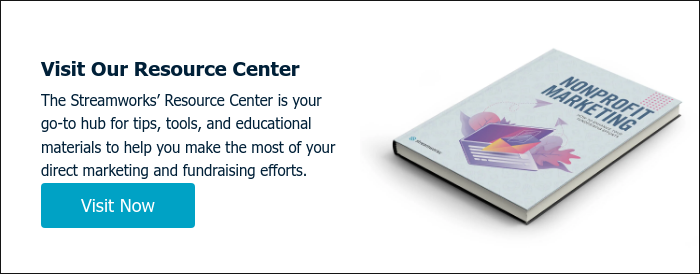Donor-Centric Direct Mail
Streamworks Blog

Direct mail is going to be one of the essential tools in your arsenal as a nonprofit.
From appeals to campaign updates, there are a variety of ways to keep your donors engaged with you utilizing direct mail.
Why direct mail? The numbers indicate that:
• 50% of donors are more likely to respond to a #10 envelope and personalized letter direct mail appeal when they receive multiple touches (such as via social media and email)
• 35% of donors say they prefer to respond to direct mail by giving online or via mobile devices
• Donors are 3x more likely to donate online in response to a direct mail appeal than by an e-appeal (newsletter or social media post)
Your direct mail campaigns should include the following four elements:
• Entertainment factor
• Personal message
• Conversational tone
• Multiple calls to action
Entertainment Factor
Even with a serious message, there are always ways to bring your reader into the picture. You can accomplish this through an anecdote or a personal experience.
A great way to accomplish this is through a story. You want to evoke a sense of empathy and compassion in your reader, so by focusing your message on one account, it will increase the likelihood of them donating.
Personal Message
Donors wish to receive communications from a person, not your organization. Have your messages come from a real person, whether that's the Executive Director or a development professional.
Conversational Tone
Your letter, appeal, and newsletter should come across how someone would talk. Include words like "I" and "me" when writing your copy, and try to eliminate any corporate tone from your message.
Multiple Calls to Action
Don't just leave your call to action at the end of your letter. You'll want to sprinkle the ask throughout your piece.
Try to include it at least three times, but make sure you work it in organically into your copy. An example of this could be "we're able to help support people like [name] thanks to contributions from people like you. Consider donating any amount so we can continue to help people like [name] now and in the future."
Here are some direct mail pieces you should have in your toolkit and work into your direct mail campaigns.
Awareness Mailings
These are a great way to reach out to new prospects. Whether it's with an envelope or a postcard, awareness mailings are a great way to warm potential donors up to your organization.
Keep your list clean and targeted to reduce mailing expenses. Evoke emotion with potential donors who tare learning about your organizations' mission.
Appeal Campaigns
Arguably your most critical direct mail piece, appeal campaigns are a crucial part of your nonprofit mailings.
Pro Tip: send out an appeal to donors within 90 days of them signing up to a newsletter or attending an event.
If you're looking to make the appeal easy for your donors, you can utilize a #10 envelope with a return envelope and pledge card. If you want to encourage online donations, try a self-mailer format to visually explain why their contributions are needed and drive them to your website.
Thank You Mailings
Each time you receive a donation, be sure you send them a thank you to recognize them. You can streamline this process by pre-printing postcards or utilizing bulk mailings.
Pro Tip: Personalization is more important than speed when it comes to reaching out and personally thanking your donors. Try inkjetting a variable note, ex: <First Name>, Thank you for your generous donation.
Newsletters
Sending out a physical reminder of the good your organization is doing, at least twice a year, is a great way to keep your donors engaged. A substantial piece that creates an emotional connection and highlights on a higher level what your organization is doing is a great way to encourage donations.
Pro Tip: Rather than recreate the wheel, pull newsletter content from your monthly email communications to reinforce your messaging.
Remarketing Messages
These are a great way to reengage with people who have visited your website but chose not to donate.
Using reverse IP address lookup, you can obtain the name and postal address of your lost website visitors. This allows you to add them to your prospect list so you can send them targeted print pieces. The piece can be a simple pre-printed postcard encouraging donors to revisit your site.
Events
Save the dates and invitations are a great form of engagement for your donors and a no-brainer.
Pro Tip: on your RSVP card, include an option where your donor can decline to attend, but still donate should they wish to do so.
Annual Reports
Your major gift contributors should receive mailed copies of your annual report each year. Annual reports are a great way to keep donors engaged, show donation dollar allocations, and the good that their contributions are making in your organization.
Consider the following when you create a direct mail campaign:
Make your donors feel awesome
Be sure to talk up your donors every chance you get. After all, they're the reason you're able to do what you do! You don't have to sing their praises, but you should always thank them multiple times every chance you get. Who doesn't like feeling appreciated, right?
Keep it simple
Studies show that the average attention span has shrunk over the years to about 8 seconds. Your copy should be short, concise, and skimmable to get your message across. Consider including compelling visuals, attention-grabbing graphics, and simple language to ensure you keep your donor engaged.
Pro Tip: Including a PostScript is a great way to keep your donors engaged as it's one of the most highly read parts of any letter.
Keywords are key
When it comes to your direct mail campaign, make sure a few keywords stand out to grab your donors' attention.
• Donor's Name: Personalization boosts engagement by showing you took the time to include their name, rather than send a blanket letter.
• Tax-deductible: Knowing they can get a tax write-off showcases an immediate benefit to your donor.
• You: Using "you" language ("your" support, thanks to "you") puts the donation in perspective for your donor and makes them feel more connected to your mission and willing to give.
• Give: Change your way of thinking, so you're encouraging your donors to "give" instead of offering "support."
Put yourself in the shoes of your supporter, and think about what is important to them. Make sure you use these words in your template.
By using these tactics as part of your integrated marketing strategy, you can craft messaging that leaves a lasting impression with your current and potential donors.


.jpg?width=352&name=770X310-Simplify-V3%20(1).jpg)
%20(1).jpg?width=352&name=PURLBlogPhoto-(1)%20(1).jpg)
